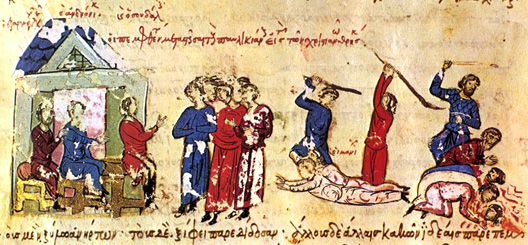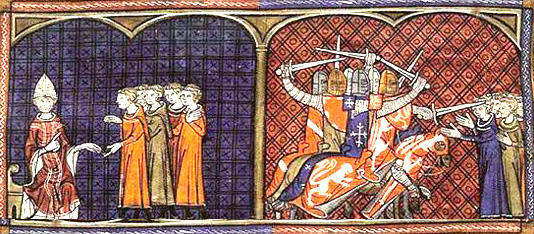|
|
|
|
|
|
[adapted from Walker, 4]
[19.1]
THE
GREEK
CHURCH
after the
ICONOCLASTIC
CONTROVERSY
The Isaurian dynasty in Constantinople (717-802), witnessed the severe internal conflicts caused by the iconoclastic controversy, which was in a measure a struggle for the freedom of the church from imperial control. It beheld the loss of Rome and of the Exarchate, and the rise of the renewed Western empire under Charlemagne. The periods of the Phrygian (820-867) and Macedonian dynasties (867-1057) were marked by a notable revival of learning, so that, intellectually, the East was decidedly superior to the West. The patriarch, Photius, whose quarrel with Nicholas I has already been noted, was of eminent scholarship. His Myriobiblon is of permanent worth, as preserving much of ancient classical authors otherwise lost. Symeon “Metaphrastes” compiled his famous collection of the lives of the Eastern saints in the tenth century. In Symeon, “the New Theologian” (?-1040?), the Greek Church had its noblest mystic, who believed that the revelation of the divine light—the very vision of God—is possible of attainment and is of grace, bringing peace, joy, and justification. Theologically, the Greek world had nothing new to offer. It held with intensity to the traditions of the past.
The chief religious controversy in the East of this epoch was that caused by the Paulicians. The origin and history of the movement is obscure. They called themselves Christians simply, their nickname being apparently due to their reverence for Paul the Apostle, rather than as sometimes claimed to any real connection with Paul of Samosata. The movement appears to have begun with a Constantine-Silvanus, of Mananalis, near Samosata, about 650-660. In it ancient heretical beliefs, akin to and perhaps derived from the Marcionites and Gnostics, reappeared. Though the Paulicians repudiated Manichæism, they were dualists, holding that this world is the creation of an evil power, while souls are from the kingdom of the good God.
[1] They accepted the New Testament, with the possible exception of the writings ascribed to Peter, as the message of the righteous God.
[2] They viewed Christ as an angel sent by the good God, and hence Son of God by adoption. His work was primarily that of instruction.
[3]They, rejected [:]
monasticism,
the external sacraments,
the cross, images, and relics.
[4] Their ministry was that of wandering preachers and “copyists.”
[5] They repudiated Catholic hierarchy. They opposed the externalism of current orthodox religious life.
The Paulicians seem to have spread rapidly in the Eastern empire, and to have taken strong root in Armenia. Persecuted by the orthodox, their military powers procured them considerable respect.

Constantine V transplanted colonies of them to the Balkan peninsula in 752, as a defense against the Bulgarians —a process which was repeated on a larger scale by the Emperor, John Tzimiskes, in 969. There they seem to have given origin to the very similar Bogomiles, who in turn were to be influential in the development of the Cathari of southern France.

Driven to seek refuge among the Saracens, some sections of the Paulicians harassed the borders of the empire in the ninth century, and even penetrated deeply into it, till their military success, though not their religious activity, was permanently checked by the Emperor, Basil I, in 871.
The latter half of the ninth and the tenth centuries was a period of revived military power for the Eastern empire, especially under John Tzimiskes (969-976) and Basil II (976-1025). By the latter, Bulgaria and Armenia were conquered. Internal dissensions and a fear of usurping militarism weakened the empire in the eleventh century, so that the rise of the Seljuk Turks found it unprepared. In 1071 the Turks conquered a large part of Asia Minor, and in 1080 established themselves in Nicæa, less than a hundred miles from Constantinople. This great loss to Christianity was to be one of the causes leading to the Crusades.
[19.2] THE SPREAD of the CHURCH
The tenth and eleventh centuries were an epoch of large extension of Christianity. Ansgar’s work in the Scandinavian lands (ante, p. 213) had left few results. Scandinavian Christianization was a slow and gradual process. Unni, archbishop of Hamburg (918-936), imitated Ansgar, but without great success. The work was carried forward by Archbishop Adaldag (937-988). Under his influence, King Harold Bluetooth of Denmark accepted Christianity, and Danish bishoprics were established. Under Harold’s son, Sweyn, heathenism was again in power; but he was brought to favor the church in 995, and the work was completed in Denmark by King Canute the Great (1015-1035), who also ruled England and, for a time, Norway.
The story of Norway is similar. Some Christian beginnings were made under Hakon I (935-961), and missionaries were sent by Harold Bluetooth of Denmark. Christianity in Norway was not permanently established till the time of Olaf I (995-1000), who brought in English preachers. The work was now extended to the Orkneys, Shetland, Hebrides, Faroe, Iceland, and Greenland, then in Scandinavian possession. Olaf II (1015-1028) enforced Christianity in Norway with such extreme measures that he was deposed and Canute gained control; yet he lives in tradition as St. Olaf. Magnus I (1035- 1047) completed the work.
In Sweden, after many beginnings from the time of Ansgar, Christianity was effectively established by King Olaf Sköttkonung (994-1024), who was baptized in 1008. Yet the work was slow, and heathenism was not fully overthrown till about 1100. Finland and Lapland were not reached till two centuries later.
After various efforts in the tenth century, Christianity was effectively established in Hungary by King Stephen I (997- 1038), the organizer of the Hungarian monarchy, who lives in history as St. Stephen. The Polish duke, Mieczyslaw, accepted Christianity in 967, and in 1000 King Boleslaus I (992-1025) organized the Polish church with an archbishopric in Gnesen. Pomerania was not Christianized till 1124-1128.
The movements just considered were the work of the Latin Church. The great extension of the Greek Church lies in this period and was accomplished by the conversion of Russia. Its beginnings are obscure. Efforts for the spread of Christianity in Russia seem to have been made as early as the time of the patriarch of Constantinople Photius (866). The Russian Queen, Olga, received baptism on a visit to Constantinople in 957. The work was at last definitely established by Grand- duke Vladimir I (980-1015), who received baptism in 988, and compelled his subjects to follow his example. A metropolitan, nominated by the patriarch of Constantinople, was placed at the head of the Russian church, with his see speedily in Kiev, from which it was transferred in 1299 to the city of Vladimir, and in 1325 to Moscow.
This Webpage was created for a workshop held at Saint Andrew's Abbey, Valyermo, California in 1990